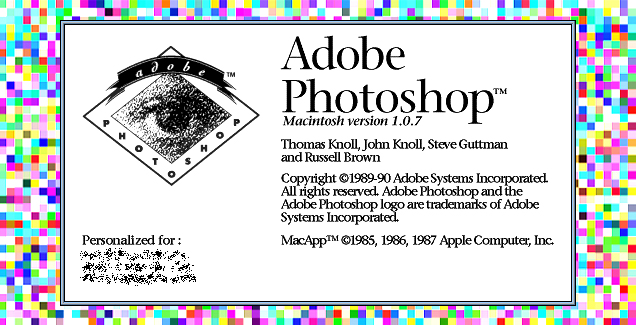I don’t remember what the first thing I ever made in Photoshop was, much less why. What brought me to the software in 1996, at age 13, is a faded memory. But I’d like to think that I saw a power in learning its magic — even then, I knew it could conjure incredible things.
It’s the 25th anniversary of Photoshop 1.0. Its commercial release on February 19, 1990, was the start of a rapid ascent not only in business terms, but cultural terms as well. It’s one of few brand names that have etched themselves into our vernacular — a noun and a verb, like Xerox or Google. To photoshop, quite simply, is to digitally manipulate an image.
There are dozens of ways to describe how Photoshop changed the internet, culture, even the artists themselves. But for me, what stands out are simply the memories of first learning the program before it was well known.
Yes, learning a computer program was memorable. In the 90s, young people used computers mainly for playing games, typing out school papers, and maybe exploring the rising phenomenon of the World Wide Web. The act of making things on the computer was a limited venture confined to programs like MS Paint. When I first saw what you could do with Photoshop, I was amazed. The novelty of taking photos and changing them; cutting parts out, pasting parts in, taking a person and putting them in a completely new setting — it was crazy. And it opened me up to how computers could be used to make things. I had no idea that this piece of software would not only give me a valuable, marketable skill — it would become a cultural touchstone.
| My first version of Photoshop |
Photoshop grew up alongside piracy culture — you could even say the two provoked each other. As a thirteen year old with no money, procuring a copy of Photoshop legally was impossible. Luckily, I was versed in piracy. It was simply a matter of logging into the right WaReZ chat room on American Online and hoping nobody in my house picked up the phone while the progz were downloading. This is what happens when a cultural artifact of such awesome power but prohibitive cost is recognised by the internet-savvy youth. Doling out hundreds for the software was not an option at my age, but giving up the chance to access this amazing tool seemed equally unthinkable.
Downloading an album or indie film screener might carry a certain guilt, but acquiring Photoshop was different. What was I supposed to do, not jump at the chance to access this revolutionary tool?
It’s rare that a high school kid knows more than the teacher. But the power of knowing Photoshop manifested itself when I enrolled in a graphic design elective in high school. Those years were no cakewalk, but here I found myself in a class where I clearly knew more than the person teaching me and breezed through the assignments with ease. For a kid who positively hated school, this was a revelation. In the years after, I honed my skills with not just Photoshop, but Illustrator, Premiere, and others. I did this completely on my own, not out of some calculated effect on my professional marketability. Because here’s another thing about this software: It’s fun.
Humans are visual creatures — the transmission of visual information is arguably the most important way we communicate. Digital images were fire, and Photoshop was the flint. It set of a paradigm shift in our collective perception of our world, from things as fleeting and petty as meme to its indelible and catastrophic impact on criminal law and international politics.
| Iran’s |
